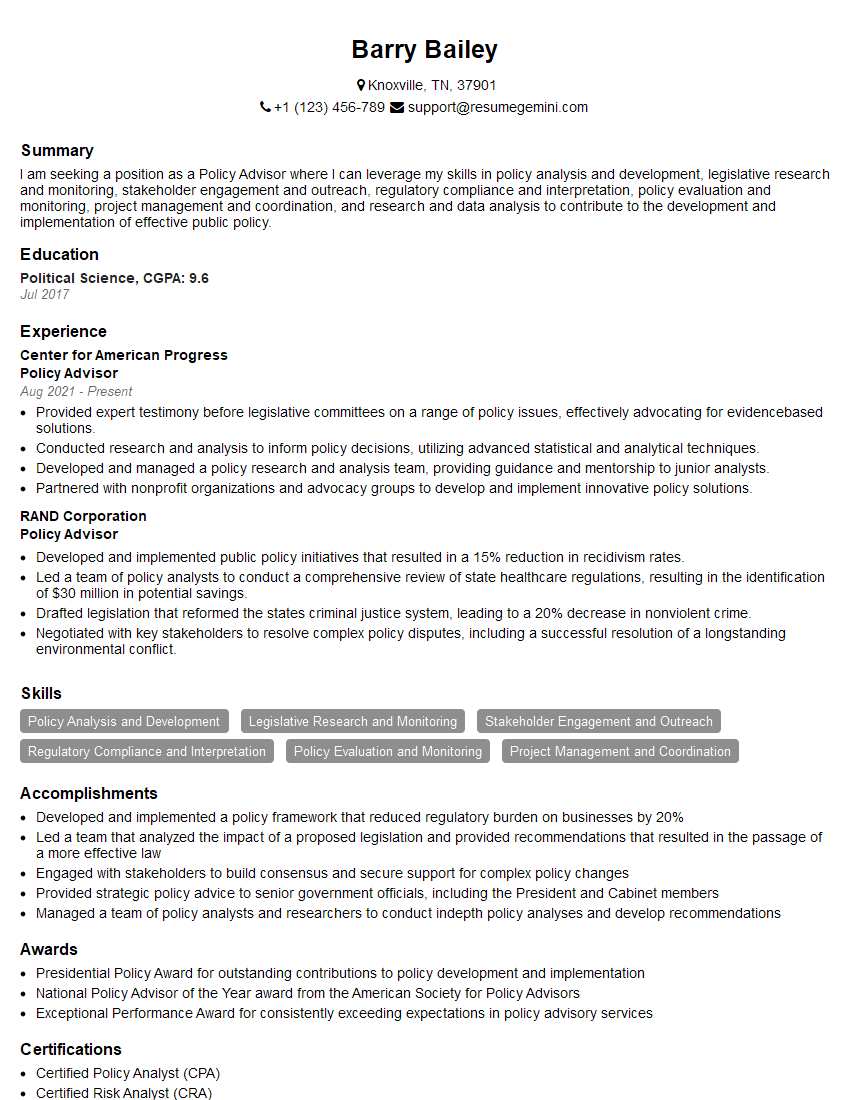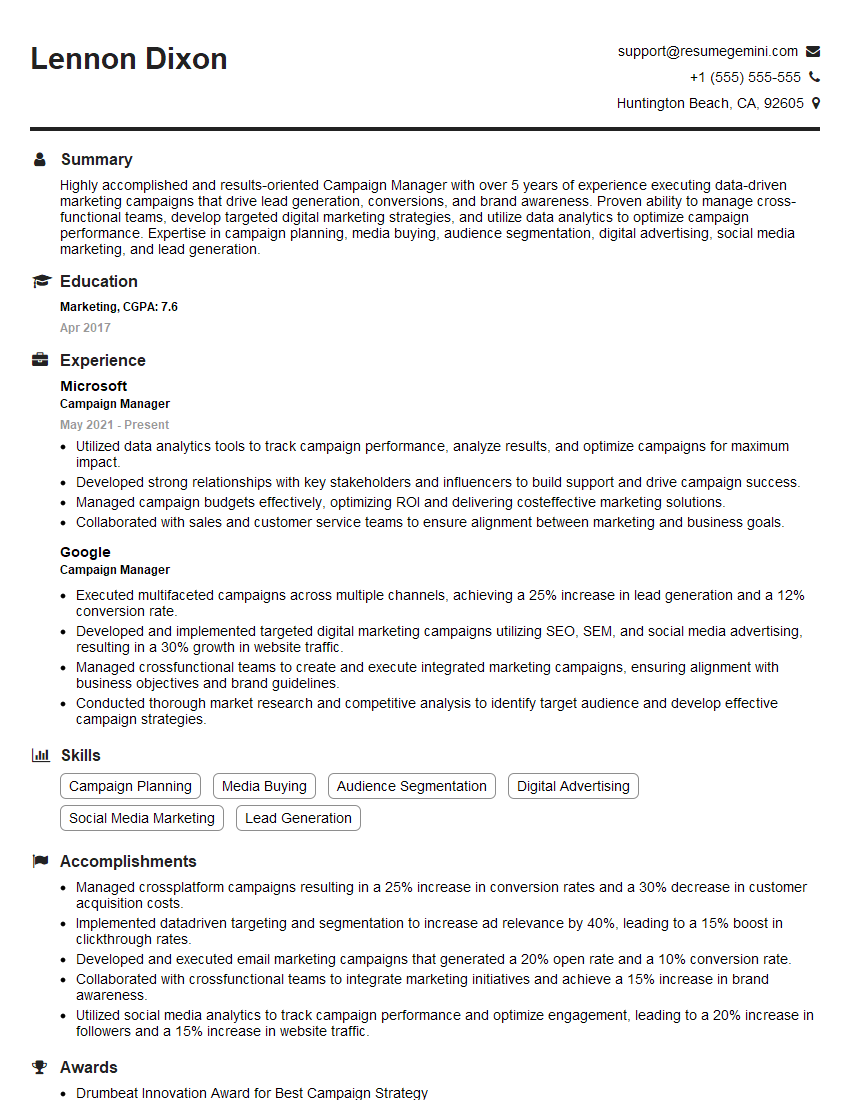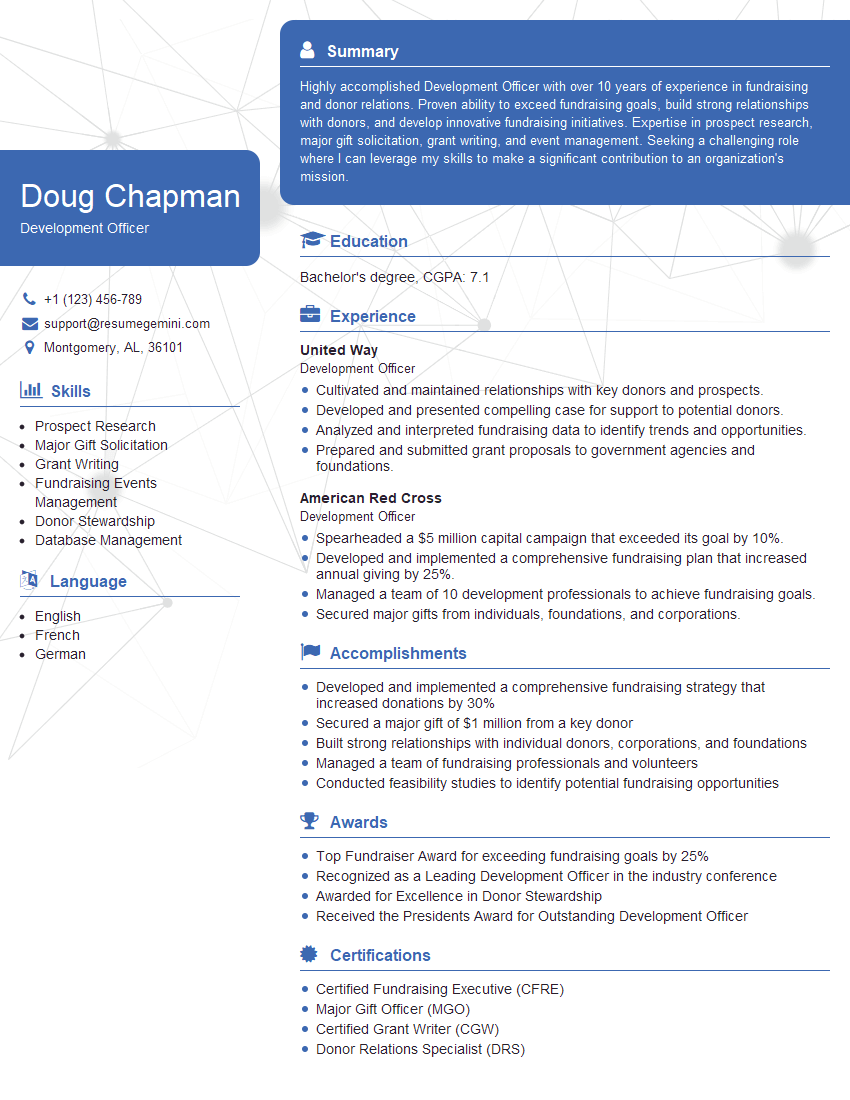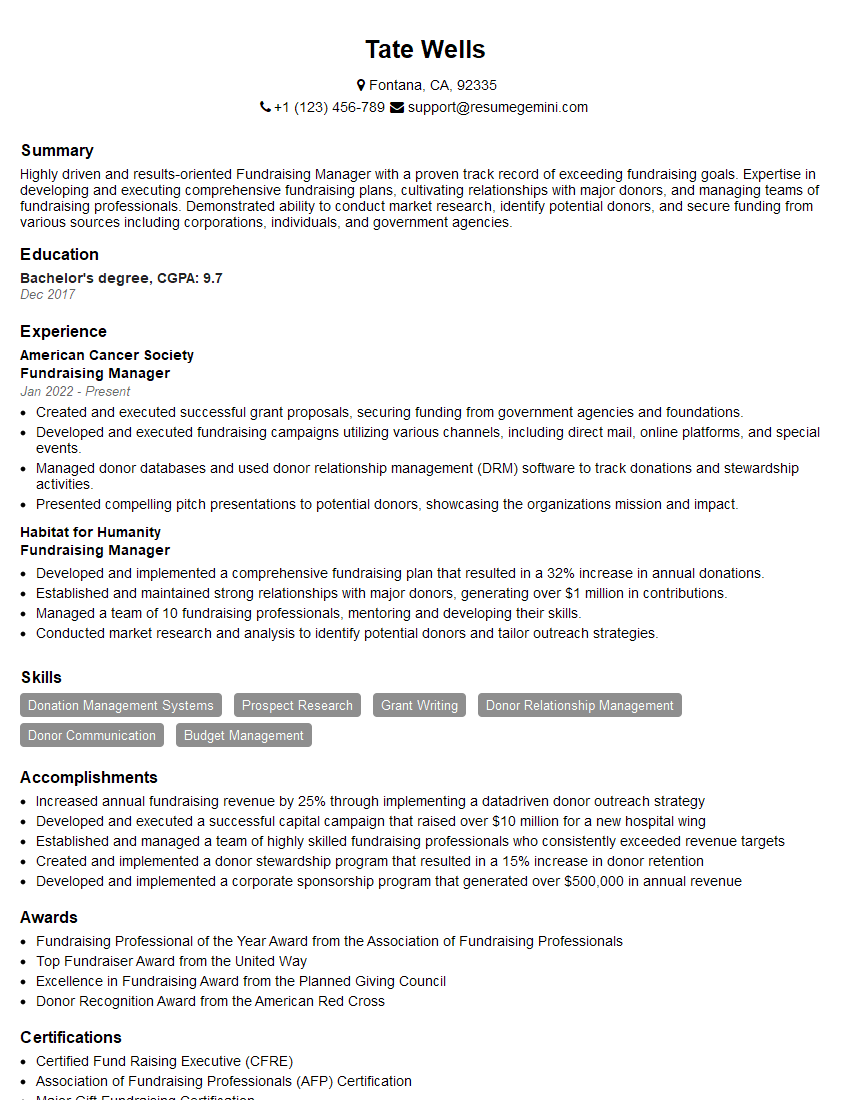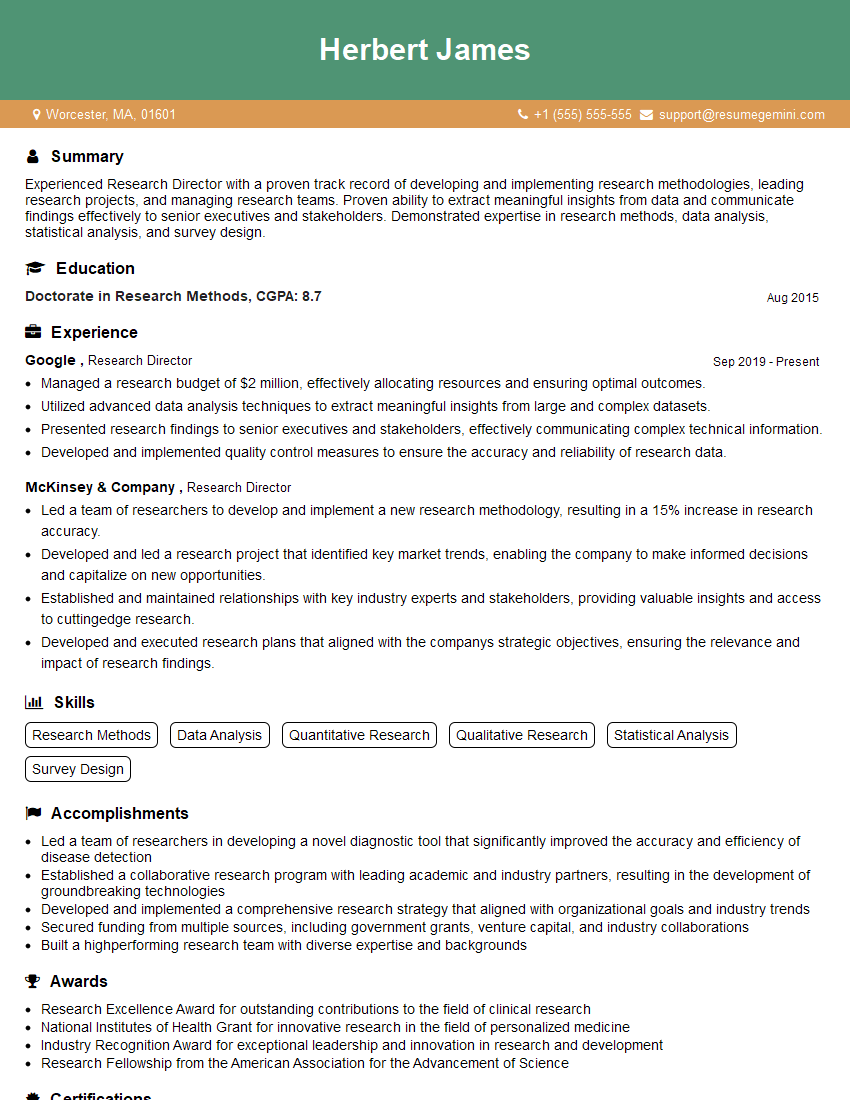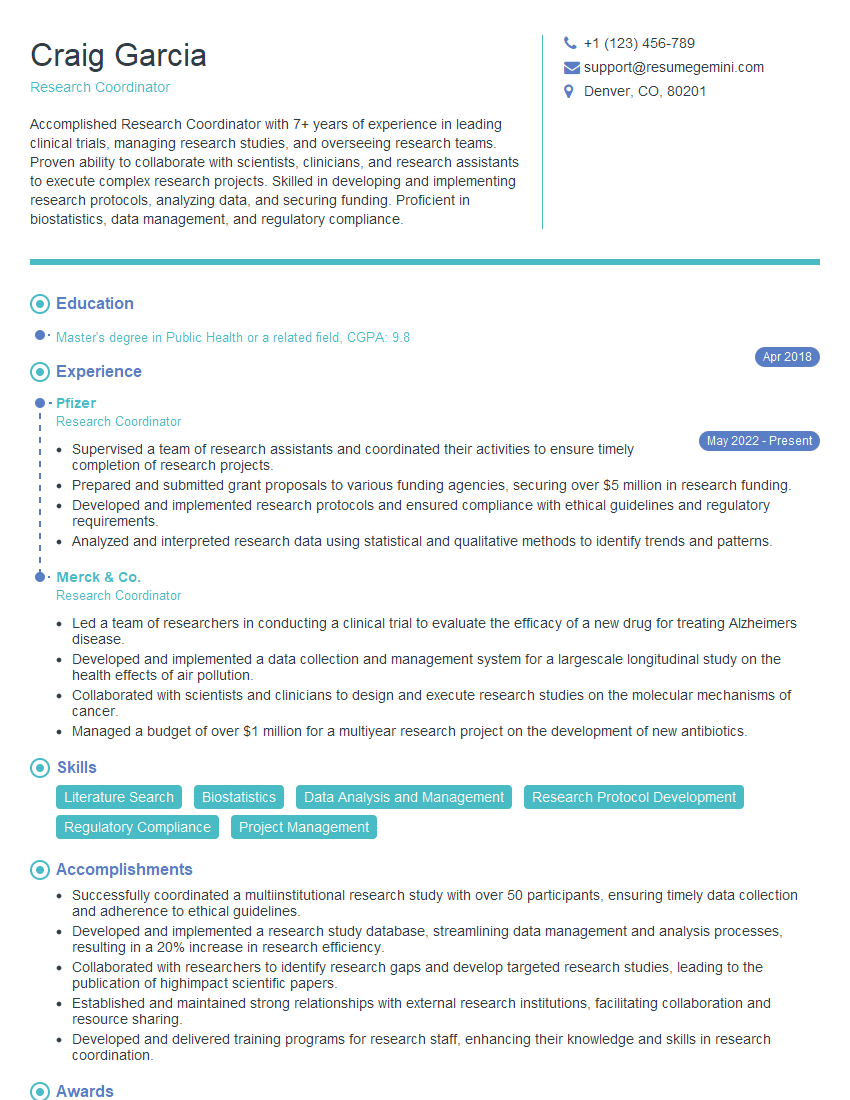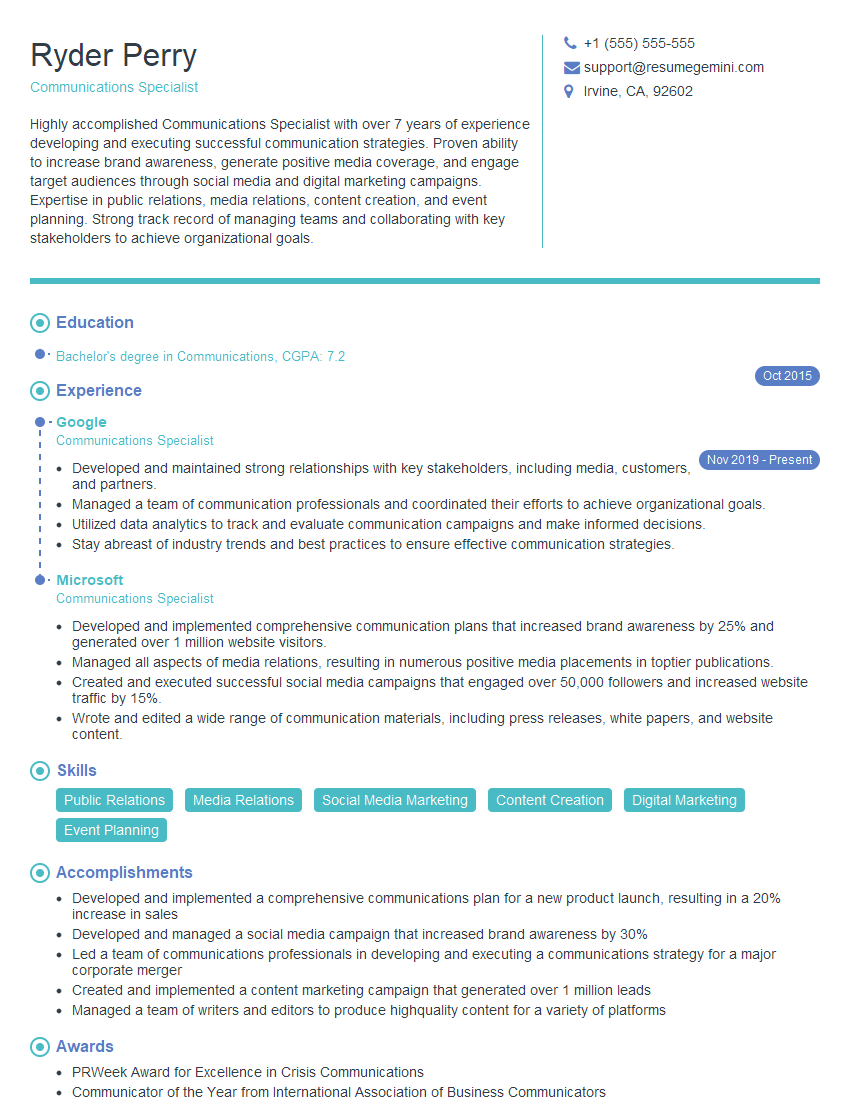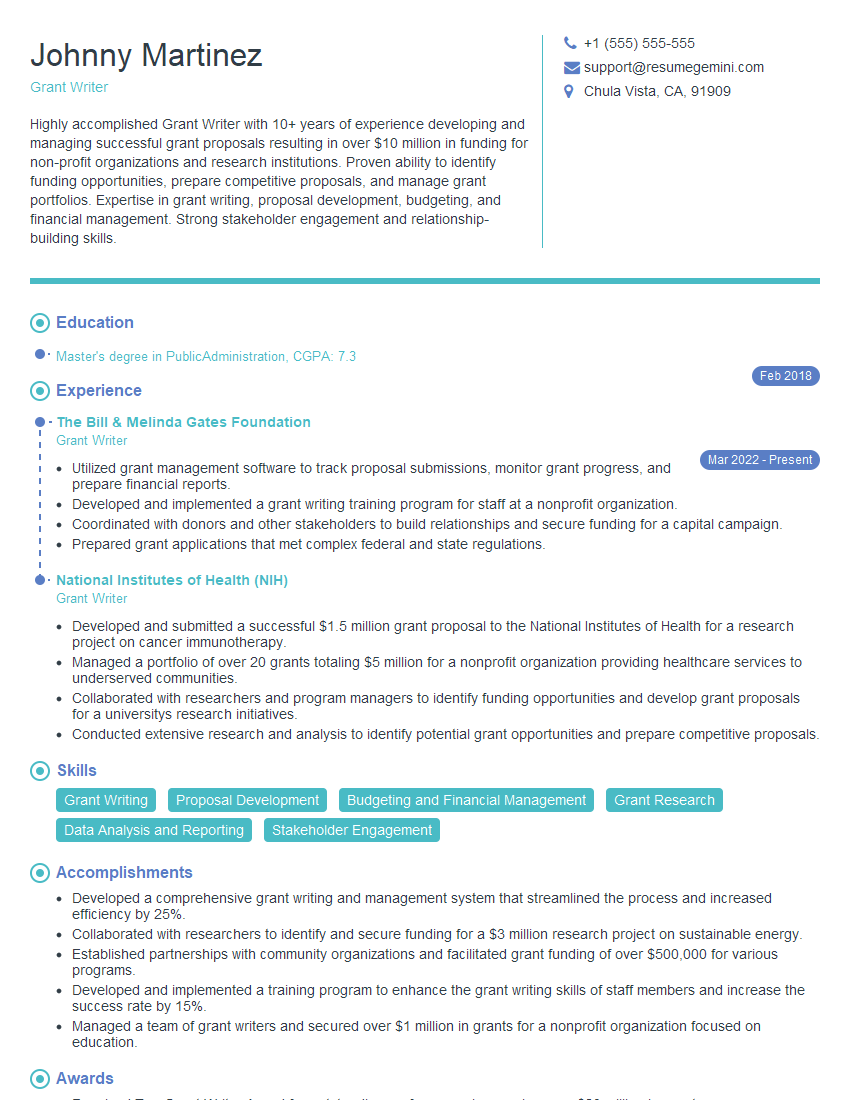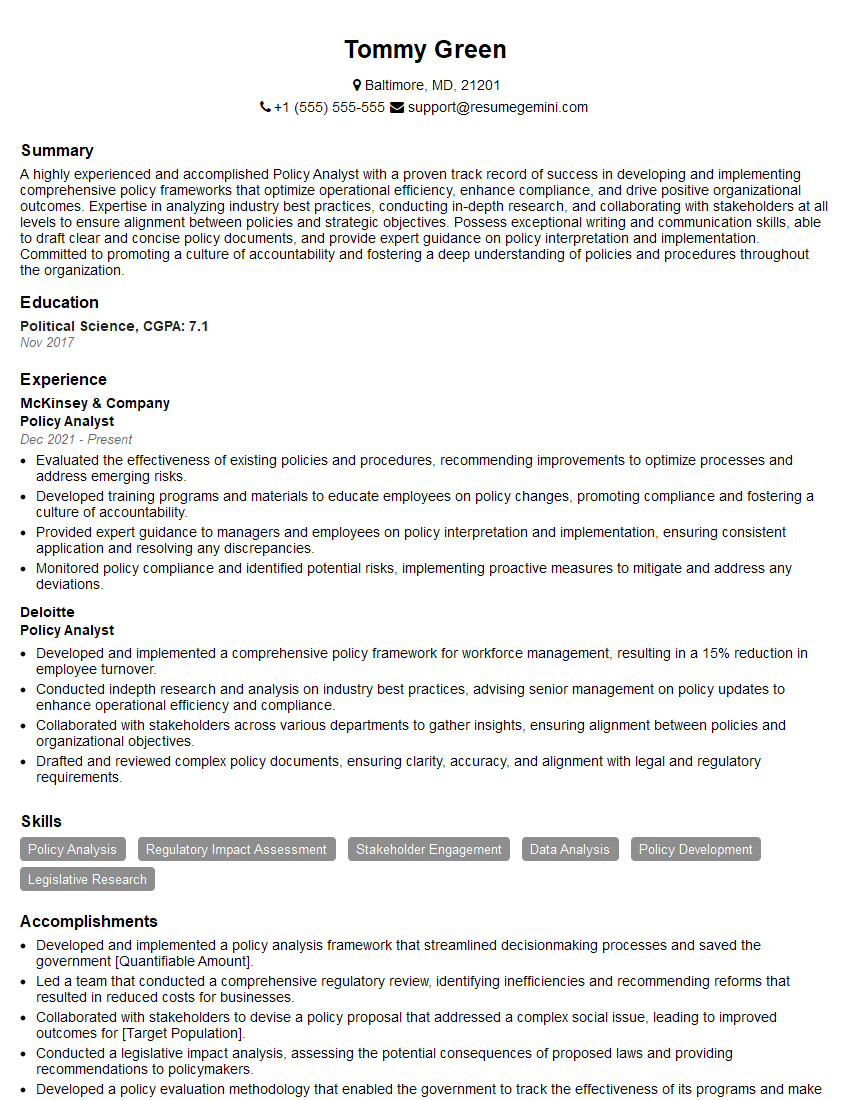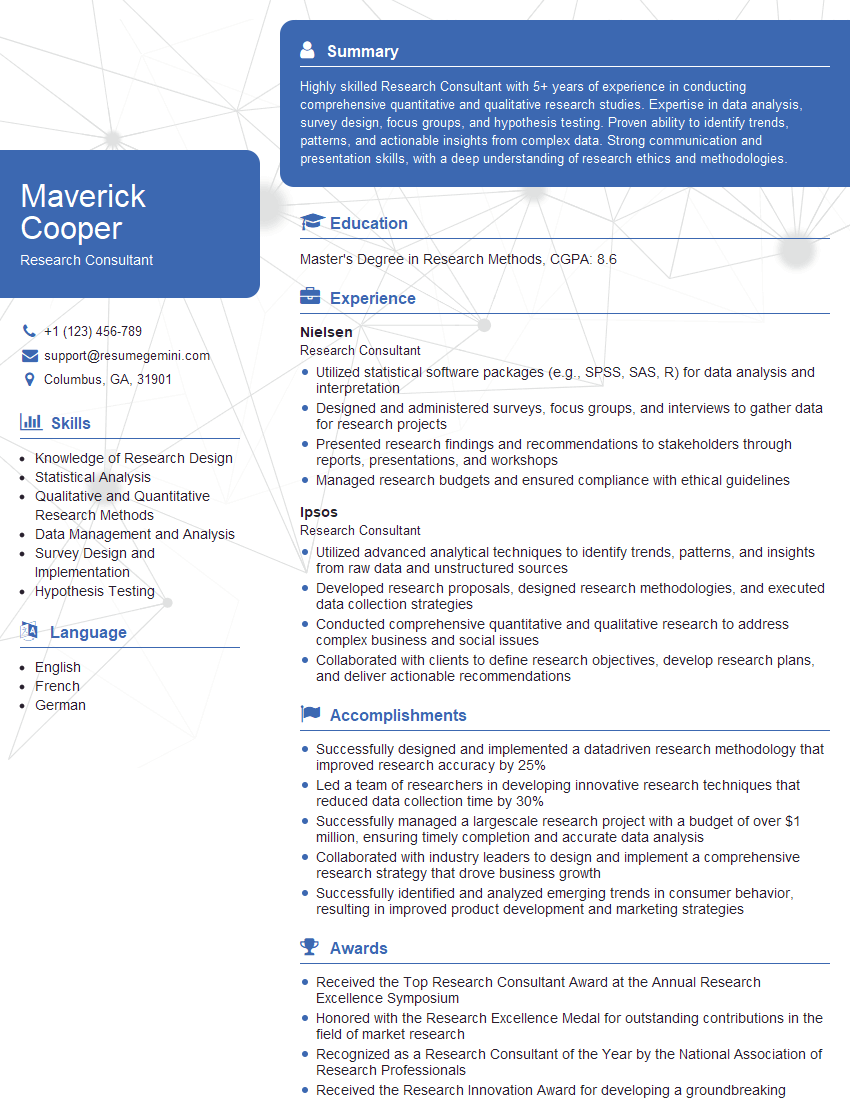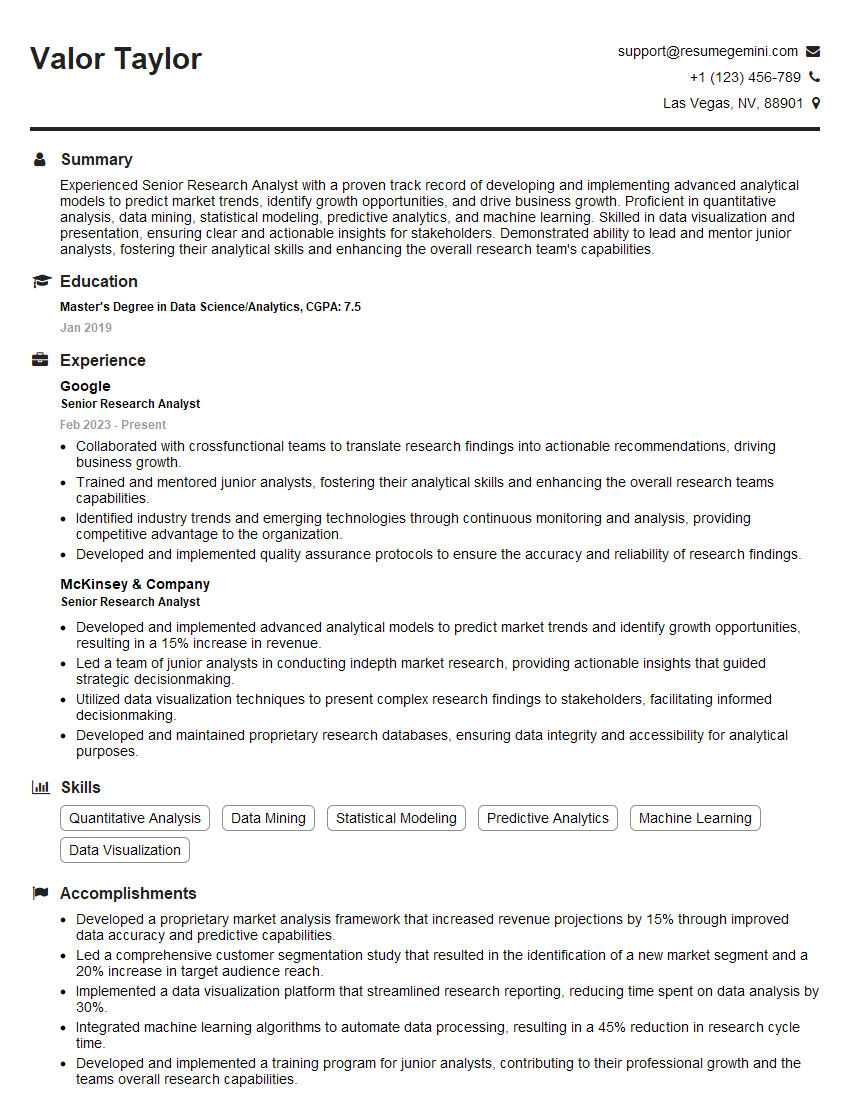Interviews are opportunities to demonstrate your expertise, and this guide is here to help you shine. Explore the essential Research and Advocacy interview questions that employers frequently ask, paired with strategies for crafting responses that set you apart from the competition.
Questions Asked in Research and Advocacy Interview
Q 1. Describe your experience designing and implementing a research project.
Designing and implementing a research project involves a systematic approach, much like building a house. You start with a strong foundation (research question), build the structure (methodology), and then furnish it (data analysis and interpretation). For example, in a project investigating the impact of a new policy on homelessness, I began by clearly defining the research question: ‘What is the effect of the new housing subsidy program on rates of homelessness among vulnerable populations in the city of Springfield?’ This guided the entire process. Next, I designed the methodology, including a mixed-methods approach: quantitative data analysis of government statistics on homelessness before and after policy implementation and qualitative data collection through interviews with individuals experiencing homelessness and service providers. This allowed for a comprehensive understanding. The project involved rigorous data collection, meticulous analysis using statistical software like SPSS and thematic analysis of qualitative data, and ultimately, a detailed report with findings and recommendations. The entire process was guided by established research ethics and standards, ensuring the validity and reliability of the results.
Q 2. Explain your process for identifying and analyzing key stakeholders in an advocacy campaign.
Identifying and analyzing key stakeholders is crucial for a successful advocacy campaign. Think of it as mapping the terrain before embarking on a journey. I start by defining the issue and its impact, then create a stakeholder map, categorizing individuals or groups based on their influence (power) and their interest in the issue. This involves researching relevant organizations, government agencies, community groups, and influential individuals. For instance, in an advocacy campaign to improve air quality in a certain region, stakeholders would include environmental groups, local residents, businesses, regulatory bodies, and elected officials. Analyzing their interests helps anticipate their potential responses to the campaign and tailor strategies accordingly. For example, businesses might be concerned about economic costs, while community groups might focus on health impacts. Understanding these nuances allows for targeted communication and building alliances.
Q 3. How do you synthesize complex research findings into actionable recommendations?
Synthesizing complex research findings into actionable recommendations requires a clear and concise communication strategy. It’s like translating complex scientific jargon into plain language that decision-makers can understand and act upon. I use a three-step approach: 1) Summarize key findings: distill the most significant results, highlighting the most important trends and patterns. 2) Interpret the findings: Explain what the findings mean in relation to the research question and its implications. 3) Develop specific, measurable, achievable, relevant, and time-bound (SMART) recommendations. For example, if research shows a correlation between access to mental health services and reduced recidivism, a recommendation might be: ‘Increase funding for community-based mental health programs by 15% within the next two years to reduce recidivism rates by 10%.’ Clear and direct recommendations coupled with evidence make it easier for decision-makers to embrace and implement them.
Q 4. What metrics do you use to measure the success of an advocacy campaign?
Measuring the success of an advocacy campaign isn’t just about counting numbers; it’s about understanding the impact. I use a combination of quantitative and qualitative metrics, tailored to the specific campaign goals. Quantitative metrics might include changes in policy, legislation passed, number of people reached through campaign activities, or shifts in public opinion (measured through surveys). Qualitative metrics could include testimonials, media coverage, changes in stakeholder attitudes, and documented shifts in organizational policy. It’s also important to track the campaign’s cost-effectiveness, comparing achieved outcomes to resources invested. For example, a successful campaign might demonstrate increased public awareness, changes in government policy, and improved stakeholder relationships, all while remaining within the allocated budget.
Q 5. Describe a time you had to adapt your research methodology due to unforeseen challenges.
Adapting research methodology is a common occurrence in research and advocacy. During a study on the effectiveness of a job training program for formerly incarcerated individuals, I initially planned to use a randomized controlled trial (RCT). However, due to challenges in recruiting participants and retaining them throughout the study period, the RCT proved unsustainable. I adapted by employing a quasi-experimental design, using a comparison group of similar individuals who did not participate in the program. This involved careful matching of participants based on demographics and relevant characteristics to minimize bias. While not as ideal as a true RCT, the adapted methodology allowed us to gather valuable data and draw meaningful conclusions, demonstrating flexibility and problem-solving skills crucial in research.
Q 6. How do you identify and prioritize advocacy targets?
Identifying and prioritizing advocacy targets is a strategic process. It’s like choosing the most effective battlegrounds in a war. I use a prioritization matrix, considering factors such as the target’s power and influence, their receptiveness to the advocacy message, the feasibility of influencing them, and the potential impact of success. For example, in a campaign to improve access to healthcare, high-priority targets might include key legislators with influence over healthcare policy, influential healthcare providers, and organizations representing affected communities. Low-priority targets might include individuals or groups with limited power or those unlikely to support the campaign. Prioritizing effectively ensures efficient allocation of resources and maximizes the impact of the advocacy effort.
Q 7. What experience do you have with data analysis and interpretation related to advocacy?
Data analysis and interpretation are essential skills in advocacy. I have extensive experience using statistical software (SPSS, R) to analyze quantitative data, identifying trends, correlations, and patterns to support advocacy arguments. For instance, I’ve used statistical analysis to demonstrate a correlation between air pollution levels and increased hospital admissions for respiratory illnesses, providing compelling evidence for policy changes. Additionally, I’m proficient in qualitative data analysis, using techniques like thematic analysis and content analysis to interpret interviews, focus groups, and survey responses, uncovering valuable insights into public opinion and stakeholder perspectives. The ability to effectively communicate these findings through compelling narratives and visualizations is crucial for influencing decision-makers and the public.
Q 8. Describe your experience working with diverse stakeholders (government, community, media).
Working effectively with diverse stakeholders – government agencies, community groups, and the media – is crucial for successful advocacy. It requires a nuanced understanding of each group’s perspectives, communication styles, and priorities. My approach centers around building trust and fostering open communication.
- Government: I’ve successfully navigated bureaucratic processes by building relationships with relevant officials, providing clear and concise policy briefs, and proactively addressing their concerns. For example, in a campaign to improve public transportation, I worked directly with city council members, providing data-driven analysis to support our proposed budget allocation.
- Community: Engaging communities effectively necessitates active listening and participatory methods. I’ve facilitated town hall meetings, focus groups, and online surveys to gather input and ensure community voices are heard. In a recent project addressing food insecurity, community feedback was essential in tailoring our intervention strategy to best meet local needs.
- Media: I understand the importance of crafting compelling narratives for media consumption. I’ve developed strong relationships with journalists by providing them with timely, accurate information and proactively responding to their inquiries. A successful media campaign I spearheaded secured widespread coverage of our advocacy efforts, resulting in increased public awareness and policymaker engagement.
Q 9. How do you build and maintain relationships with key decision-makers?
Building and maintaining relationships with key decision-makers requires a strategic and long-term approach. It’s not just about transactional interactions; it’s about cultivating genuine rapport based on mutual respect and shared goals.
- Strategic Networking: I actively participate in relevant conferences and events to connect with policymakers. I tailor my communication to each individual’s interests and concerns, demonstrating a genuine interest in their work.
- Consistent Communication: I maintain regular contact with decision-makers through email updates, briefings, and in-person meetings. I anticipate their needs and proactively provide information relevant to their responsibilities.
- Demonstrating Value: I consistently demonstrate the value of my work by providing evidence-based research and impactful results. This strengthens their confidence in my expertise and credibility.
- Building Trust: Transparency and honesty are paramount. I address concerns openly and constructively, building a foundation of trust and mutual understanding. This approach has been critical in securing buy-in from key stakeholders on several projects.
Q 10. How do you effectively communicate research findings to a non-technical audience?
Communicating complex research findings to a non-technical audience requires simplifying technical jargon and using engaging storytelling techniques. My approach focuses on clarity, relevance, and visual aids.
- Plain Language: I avoid technical terms whenever possible and use clear, concise language. I focus on explaining the “so what?” – the implications of the research and its relevance to the audience.
- Storytelling: I use storytelling to make the research relatable and memorable. This could involve case studies, personal anecdotes, or compelling visuals.
- Visual Aids: Infographics, charts, and other visual elements significantly improve understanding and retention. These aids are especially useful for illustrating complex data or presenting key findings succinctly.
- Interactive Presentations: Involving the audience through Q&A sessions and interactive elements enhances engagement and understanding. For example, when presenting research on climate change impacts, I used interactive maps to show local vulnerability levels, making it easier for community members to understand the direct implications for their area.
Q 11. Describe your experience with grant writing or fundraising for advocacy efforts.
Grant writing and fundraising are essential skills in advocacy. My experience involves crafting compelling proposals that clearly articulate the need, strategy, and impact of our initiatives.
- Understanding Funding Landscape: I thoroughly research potential funding sources, identifying those aligned with our advocacy goals. This includes reviewing funding guidelines, understanding reporting requirements, and connecting with grant officers.
- Compelling Narratives: I develop clear, concise, and persuasive proposals that highlight the significance of the issue, the project’s innovative approach, and the expected outcomes. I provide robust evidence to support our claims, utilizing relevant data and metrics.
- Budget Justification: I create detailed and well-justified budgets that align with the project scope and demonstrate value for money. I’m adept at showcasing both short-term and long-term impact to justify investments.
- Relationship Building: Cultivating relationships with grant officers is vital for securing funding. Regular communication, transparency, and prompt response to inquiries are crucial.
For example, I successfully secured a significant grant from a private foundation to support our campaign against discriminatory housing practices, by demonstrating a clear understanding of the foundation’s funding priorities and building strong relationships with their staff.
Q 12. How do you manage competing priorities and deadlines in a fast-paced advocacy environment?
Managing competing priorities and deadlines in a fast-paced advocacy environment requires strong organizational skills, effective time management techniques, and the ability to prioritize tasks strategically.
- Prioritization: I utilize frameworks like Eisenhower Matrix (urgent/important) to categorize tasks and prioritize those that align with strategic goals. I focus on high-impact activities that move the needle.
- Project Management: I utilize project management tools to track progress, deadlines, and responsibilities. This ensures tasks are completed efficiently and collaboratively.
- Delegation: I effectively delegate tasks to team members, leveraging their strengths and expertise. This allows for efficient workflow and avoids bottlenecks.
- Flexibility and Adaptability: The advocacy landscape is dynamic. I remain flexible and adaptable, adjusting to changing circumstances and prioritizing tasks as needed.
In a recent campaign, we faced several overlapping deadlines. By prioritizing tasks strategically, delegating responsibilities effectively, and using project management software, we managed to deliver all key deliverables on time and under budget.
Q 13. How familiar are you with relevant legislation and regulations impacting your area of advocacy?
I possess a strong understanding of relevant legislation and regulations impacting my area of advocacy. Staying current on legal developments is crucial for effective advocacy work. My approach involves proactive monitoring, legal research, and collaboration with legal experts.
- Continuous Monitoring: I regularly review legislative updates, regulatory changes, and court decisions relevant to my advocacy area. I use official government websites, legal databases, and professional networks to remain informed.
- Legal Research: I conduct thorough legal research to understand the implications of specific laws and regulations. This helps me identify legal avenues for achieving our advocacy goals and avoid potential legal pitfalls.
- Collaboration with Legal Experts: I work closely with legal professionals when necessary, seeking their expertise on complex legal issues. This ensures that our advocacy efforts are legally sound and effective.
For example, in our campaign for improved environmental protection, we closely monitored the updates on relevant environmental regulations, which allowed us to tailor our advocacy strategies effectively and to leverage the opportunities provided by newly passed environmental laws.
Q 14. What strategies do you employ to overcome resistance from opposing viewpoints?
Overcoming resistance from opposing viewpoints requires a thoughtful and strategic approach that values open dialogue, evidence-based arguments, and a willingness to find common ground.
- Understanding Opposing Views: I actively seek to understand the perspectives and concerns of those who oppose our advocacy goals. This empathy is vital for developing effective counterarguments.
- Evidence-Based Arguments: I present compelling evidence to support our claims, using data, research findings, and case studies to demonstrate the validity of our arguments.
- Building Consensus: I actively seek opportunities to find common ground and build consensus with opposing viewpoints. Compromise and collaboration are often essential for progress.
- Framing the Issue: I carefully frame the issue in a way that resonates with the opposing side, highlighting shared values and potential benefits. This may involve emphasizing areas of agreement or reframing the issue to highlight mutual interests.
- Strategic Partnerships: Building alliances with other organizations and individuals who share similar goals can strengthen our advocacy efforts and increase our influence.
For example, while advocating for stricter environmental regulations, we successfully engaged businesses initially opposed to these regulations by demonstrating how the new rules would enhance efficiency and competitiveness in the long run. We were also able to demonstrate economic benefits and potential job creation that would result from adopting sustainable environmental practices.
Q 15. Describe your experience with media relations and public communication of advocacy campaigns.
Effective media relations are crucial for amplifying the message of any advocacy campaign. My experience involves crafting compelling narratives, developing targeted media lists, and pitching stories to journalists across various platforms – from print and broadcast media to online news outlets and social media. I’ve worked on campaigns ranging from advocating for improved healthcare access to promoting environmental sustainability. For example, in one campaign advocating for stricter environmental regulations, we secured interviews on national television and radio, leading to significant public awareness and pressure on policymakers.
This involved proactive media outreach, such as press releases and media kits with strong visuals and data-driven information. It also included reactive strategies, responding promptly and effectively to media inquiries and addressing any criticisms or counterarguments. Building strong relationships with journalists is key, based on trust and consistent delivery of accurate and timely information. I also actively engage in social media to share updates, engage directly with the public, and address concerns.
- Strategic Media Outreach: Developing tailored press releases and media kits for different target audiences.
- Relationship Building: Cultivating long-term relationships with journalists and influencers.
- Social Media Engagement: Utilizing social media platforms to amplify messages and interact with the public.
- Crisis Communication: Developing strategies to manage and mitigate negative media coverage.
Career Expert Tips:
- Ace those interviews! Prepare effectively by reviewing the Top 50 Most Common Interview Questions on ResumeGemini.
- Navigate your job search with confidence! Explore a wide range of Career Tips on ResumeGemini. Learn about common challenges and recommendations to overcome them.
- Craft the perfect resume! Master the Art of Resume Writing with ResumeGemini’s guide. Showcase your unique qualifications and achievements effectively.
- Don’t miss out on holiday savings! Build your dream resume with ResumeGemini’s ATS optimized templates.
Q 16. How do you assess the potential risks and opportunities associated with an advocacy campaign?
Risk assessment in advocacy is a critical first step. We use a structured approach, considering both potential opportunities and threats. This involves identifying potential stakeholders (supporters, opponents, neutral parties), mapping their influence, and anticipating their reactions to our campaign strategy. We analyze potential risks, such as negative media attention, backlash from opposing groups, or unforeseen policy changes. We also identify opportunities – for example, potential alliances, favorable policy shifts, or public opinion turning in our favor.
For example, in a campaign promoting a new environmental policy, a risk might be opposition from powerful lobbying groups. An opportunity might be a shift in public opinion towards environmental issues due to a recent natural disaster. We use SWOT analysis (Strengths, Weaknesses, Opportunities, Threats) to systematically evaluate these factors. We then develop mitigation strategies for the risks and plans to capitalize on opportunities.
- Stakeholder Mapping: Identifying key stakeholders and their potential impact.
- SWOT Analysis: Assessing strengths, weaknesses, opportunities, and threats.
- Scenario Planning: Developing contingency plans for various scenarios.
- Risk Mitigation: Developing strategies to reduce the likelihood and impact of risks.
Q 17. How do you measure the impact of your advocacy efforts?
Measuring the impact of advocacy efforts requires a multi-faceted approach combining quantitative and qualitative data. Quantitative methods might include tracking media coverage, analyzing changes in public opinion (through polls or surveys), monitoring policy changes, or measuring the number of people reached through our communications. Qualitative data, gathered through interviews, focus groups, or case studies, can provide valuable insights into the lived experiences of those affected by the issue and the impact of our advocacy.
For instance, in a campaign to improve access to education, we might measure the number of new schools built or policies changed, but also conduct interviews with students and teachers to understand the qualitative changes in their lives. We use a logic model to link our activities, outputs, outcomes, and overall impact. This helps demonstrate a clear chain of events showing how our advocacy directly contributed to positive changes.
- Quantitative Measures: Media mentions, policy changes, survey results, website traffic.
- Qualitative Measures: Interviews, focus groups, case studies.
- Logic Model: A visual representation of the causal links between activities and outcomes.
- Attribution Analysis: Determining the extent to which our efforts contributed to observed changes.
Q 18. How do you stay up-to-date on relevant research and policy developments?
Staying current in research and policy is essential. I utilize several strategies: I subscribe to relevant academic journals and policy publications, regularly attend conferences and workshops, and actively participate in online communities and professional networks. I also use advanced search techniques to identify key research papers and policy documents. Utilizing government websites, think tanks, and reputable news sources for timely policy updates is crucial. Alert systems, like Google Alerts, can notify me about new developments related to my areas of interest.
For example, I might set up Google Alerts for keywords like “climate change policy” or “affordable housing initiatives.” I maintain a detailed reading list and utilize citation management tools to effectively track and synthesize information. Networking with experts in the field helps expand my knowledge and provides access to emerging research and perspectives.
- Journal Subscriptions and Databases: Accessing peer-reviewed research and policy analysis.
- Conferences and Workshops: Attending industry events and networking with peers.
- Online Communities and Networks: Participating in online discussions and knowledge sharing.
- Government Websites and Think Tanks: Monitoring policy updates and research reports.
- Alert Systems: Using Google Alerts or similar services for real-time updates.
Q 19. Describe a time you had to defend your research findings or advocacy positions.
In a campaign advocating for improved public transportation, our research showed a significant disparity in access based on income and location. We presented this data to a city council committee, but faced strong opposition from certain developers who favored car-centric development. They challenged our methodology and data interpretation, claiming our findings were biased and inaccurate. To defend our findings, I meticulously detailed our research process, providing complete transparency regarding our data sources, methodologies, and statistical analysis.
We also presented independent corroborating evidence from other studies and reports to strengthen our argument. Through clear and concise communication, backed by strong evidence, we were able to effectively address their concerns and ultimately, the committee acknowledged the validity of our findings, leading to policy recommendations aligning with our advocacy goals.
- Transparency: Ensuring complete openness and clarity in methodology and data sources.
- Evidence-Based Argumentation: Backing up claims with robust data and credible sources.
- Addressing Counterarguments: Anticipating and refuting potential criticisms.
- Effective Communication: Presenting information clearly and concisely to diverse audiences.
Q 20. What ethical considerations are most important in your research and advocacy work?
Ethical considerations are paramount in research and advocacy. Transparency, honesty, and integrity are fundamental. This includes acknowledging limitations in research findings, avoiding conflicts of interest, ensuring informed consent (where applicable), protecting the privacy of participants, and representing data accurately and responsibly. It’s critical to maintain objectivity and avoid bias, while also being mindful of the potential impact of our advocacy on vulnerable populations.
For instance, ensuring that research participants are aware of the purpose of the study and their right to withdraw at any time is crucial. Likewise, we must avoid cherry-picking data to support pre-determined conclusions. We must also be accountable for our actions and their consequences, being responsive to feedback and corrections when necessary.
- Transparency: Openly sharing research methods and data.
- Objectivity: Avoiding bias in data collection and interpretation.
- Informed Consent: Ensuring participants understand the research process.
- Data Privacy: Protecting the confidentiality of participants.
- Accountability: Taking responsibility for our actions and their impact.
Q 21. How do you utilize data visualization tools to present research findings?
Data visualization is a powerful tool for communicating research findings effectively. I utilize various tools and techniques depending on the audience and the type of data being presented. Simple charts, such as bar graphs and line graphs, are useful for showing trends and comparisons. More complex data visualizations, such as heatmaps or interactive dashboards, can be used to explore large datasets or show relationships between multiple variables. I frequently use software such as Tableau, Power BI, or even simpler tools like Excel to create these visualizations.
For example, if presenting research on income inequality, a simple bar graph could compare average income across different demographic groups. A more complex interactive map could display income levels geographically, allowing the audience to explore variations across different neighborhoods. The key is to choose the right tool and technique that best communicates the findings clearly and engagingly, keeping in mind the audience’s level of understanding.
- Chart Types: Bar graphs, line graphs, pie charts, scatter plots, heatmaps.
- Interactive Dashboards: Allowing users to explore data interactively.
- Geographic Information Systems (GIS): Mapping data geographically.
- Software: Tableau, Power BI, Excel, R.
- Principles of Design: Clarity, simplicity, and accessibility.
Q 22. What software or tools are you proficient in for research and data analysis?
My proficiency in software and tools for research and data analysis is quite extensive. For quantitative analysis, I’m highly skilled in statistical software packages like R and SPSS. R, with its powerful libraries like dplyr for data manipulation and ggplot2 for visualization, allows for complex statistical modeling and insightful data exploration. SPSS offers a user-friendly interface ideal for managing large datasets and conducting various statistical tests. For qualitative data, I utilize NVivo for thematic analysis, coding, and managing qualitative data sets. Furthermore, I’m comfortable using spreadsheet software like Microsoft Excel and Google Sheets for data cleaning, basic analysis, and report generation. Finally, I utilize dedicated bibliographic management software like Zotero to organize and cite my sources efficiently.
Q 23. Describe your experience with qualitative and quantitative research methods.
I have significant experience with both qualitative and quantitative research methods. Quantitative research involves numerical data and statistical analysis to identify patterns and test hypotheses. For example, I recently conducted a quantitative study analyzing the correlation between social media usage and political engagement using regression analysis in R. The results were then presented visually using charts and graphs generated in ggplot2.
Qualitative research, on the other hand, focuses on in-depth understanding of experiences, perspectives, and meanings. I’ve used qualitative methods, such as semi-structured interviews and focus groups, to explore the lived experiences of individuals affected by a specific policy. The data from these interviews was analyzed using thematic analysis in NVivo, allowing me to identify recurring themes and patterns in the narratives.
The choice between qualitative and quantitative methods depends on the research question and the type of data needed to answer it effectively. Often, a mixed-methods approach, combining both qualitative and quantitative data, provides the most comprehensive understanding.
Q 24. How do you manage your time effectively when working on multiple research or advocacy projects?
Managing time effectively across multiple research and advocacy projects requires a structured approach. I utilize project management tools like Trello or Asana to track tasks, deadlines, and progress. This allows me to visualize all my projects simultaneously and prioritize tasks based on urgency and importance. I break down large projects into smaller, manageable tasks with clearly defined milestones. This prevents feeling overwhelmed and allows for regular progress checks. Time blocking is also crucial; I schedule specific time slots for different activities, ensuring focused work periods. Finally, regular review and adjustment of my schedule is essential to account for unexpected delays or changes in priorities.
Q 25. What is your approach to collaboration and teamwork within a research and advocacy context?
Collaboration is fundamental to successful research and advocacy. My approach is built on clear communication, shared goals, and mutual respect. I believe in establishing clear roles and responsibilities from the outset, ensuring everyone understands their contribution to the project. Regular team meetings, utilizing tools like Zoom or Google Meet, are essential for progress updates, brainstorming, and addressing challenges. I value active listening and encourage open dialogue, ensuring everyone’s perspectives are considered. I also prioritize constructive feedback and conflict resolution, aiming for a collaborative and supportive team environment. For example, in a recent campaign, we used a shared Google Doc to collaboratively draft our policy recommendations, allowing for real-time feedback and efficient revision.
Q 26. Describe your experience with developing and implementing a communications plan for an advocacy campaign.
Developing and implementing a communications plan for an advocacy campaign involves a strategic approach focusing on target audience engagement and desired outcomes. First, I define clear objectives and key messages, ensuring alignment with the campaign’s overall goals. Next, I identify the key target audiences and their preferred communication channels. This might include social media, email marketing, press releases, or community outreach events. I then create a detailed plan outlining the specific communication activities, timelines, and responsible parties. This includes creating compelling content tailored to each audience, utilizing various mediums like infographics, videos, and blog posts. Regular monitoring and evaluation are crucial to track the campaign’s effectiveness and make necessary adjustments throughout its duration. For instance, in one campaign, we leveraged social media to amplify our message and build a strong online community, engaging users through interactive polls and Q&A sessions.
Q 27. How do you identify and mitigate potential biases in your research?
Identifying and mitigating potential biases is critical to conducting rigorous and credible research. I use several strategies to address this. First, I strive for reflexivity, regularly examining my own biases and assumptions, recognizing that they can unconsciously influence research design, data collection, and analysis. Second, I employ diverse data collection methods and diverse research teams to gain multiple perspectives and reduce the risk of skewed findings. Third, I rigorously document my research methods and decision-making processes, allowing for transparency and scrutiny by others. Finally, I carefully analyze data for potential bias, using statistical methods where appropriate to identify systematic errors or outliers. For example, in a study exploring gender disparities, I made a conscious effort to involve researchers with different gender identities and ensured my sampling strategy minimized potential biases.
Q 28. How do you handle conflicting information or data sources during research?
Handling conflicting information or data sources requires careful consideration and critical evaluation. I start by critically assessing the credibility and reliability of each source, considering factors like the source’s expertise, potential biases, and methodology. I then cross-reference the information across multiple sources, looking for corroborating evidence. If the discrepancies persist, I might seek additional data or conduct further research to resolve the inconsistencies. It’s important to document the conflicting information and the steps taken to resolve the discrepancies transparently. In some cases, acknowledging the uncertainty might be necessary, especially if definitive resolution isn’t possible. For example, when encountering conflicting statistics on a particular policy’s effectiveness, I would investigate the different methodologies used, search for peer-reviewed studies, and if necessary, might contact experts in the field for clarification.
Key Topics to Learn for Research and Advocacy Interview
- Research Methods: Understanding qualitative and quantitative research methodologies, data collection techniques (surveys, interviews, focus groups), and data analysis approaches. Consider practical applications like designing a study to evaluate the impact of a specific policy.
- Advocacy Strategies: Developing effective communication strategies for different audiences (policymakers, media, public), crafting compelling narratives, and building coalitions. Think about how you would advocate for a specific cause using different channels.
- Policy Analysis: Analyzing policy documents, identifying policy gaps and opportunities, and evaluating policy effectiveness. Practice applying frameworks to analyze real-world policy challenges.
- Stakeholder Engagement: Identifying and engaging with key stakeholders, building consensus, and managing conflict. Consider scenarios involving diverse stakeholder groups with conflicting interests.
- Data Visualization and Communication: Effectively presenting research findings through clear and compelling visuals (charts, graphs, infographics) and written reports. Practice communicating complex information concisely and accessibly.
- Ethical Considerations: Understanding ethical principles in research and advocacy, including informed consent, data privacy, and conflict of interest. Prepare examples demonstrating your commitment to ethical conduct.
Next Steps
Mastering research and advocacy skills opens doors to impactful and fulfilling careers, allowing you to contribute meaningfully to societal change. A strong resume is your key to unlocking these opportunities. An ATS-friendly resume, optimized for applicant tracking systems, significantly increases your chances of getting your application noticed. To build a powerful resume that showcases your skills and experience effectively, we highly recommend using ResumeGemini. ResumeGemini provides a user-friendly platform and offers examples of resumes tailored specifically to Research and Advocacy roles, helping you craft a compelling document that highlights your unique strengths and achievements.
Explore more articles
Users Rating of Our Blogs
Share Your Experience
We value your feedback! Please rate our content and share your thoughts (optional).
What Readers Say About Our Blog
Hi, I have something for you and recorded a quick Loom video to show the kind of value I can bring to you.
Even if we don’t work together, I’m confident you’ll take away something valuable and learn a few new ideas.
Here’s the link: https://bit.ly/loom-video-daniel
Would love your thoughts after watching!
– Daniel
This was kind of a unique content I found around the specialized skills. Very helpful questions and good detailed answers.
Very Helpful blog, thank you Interviewgemini team.
